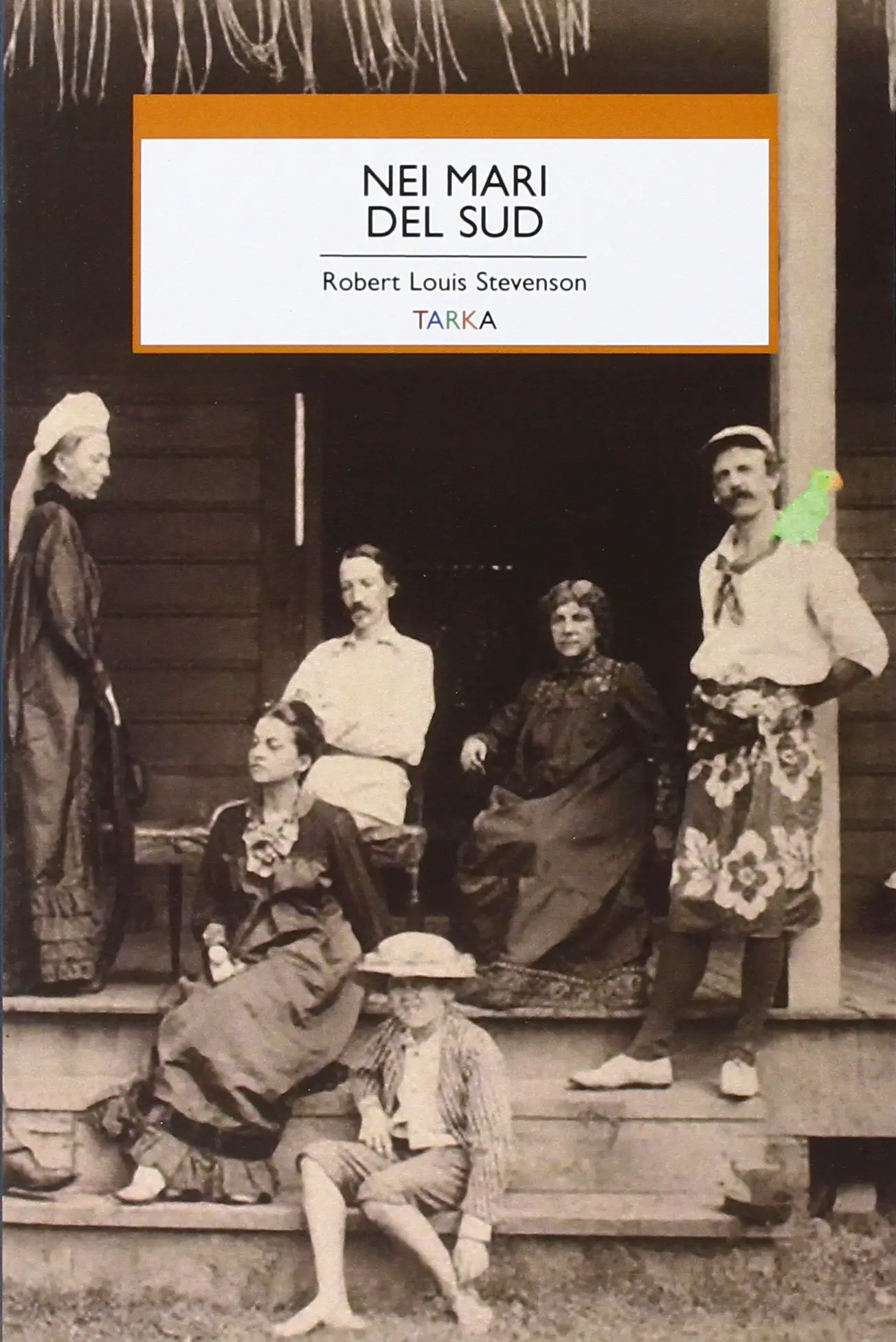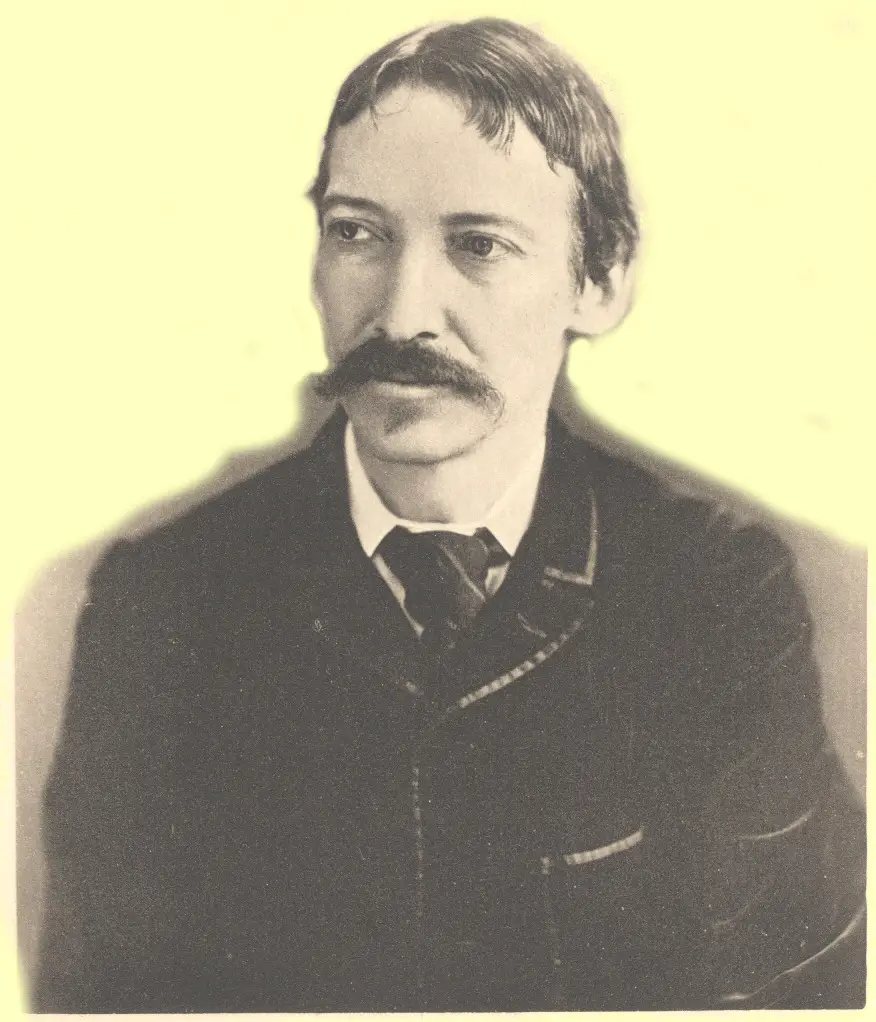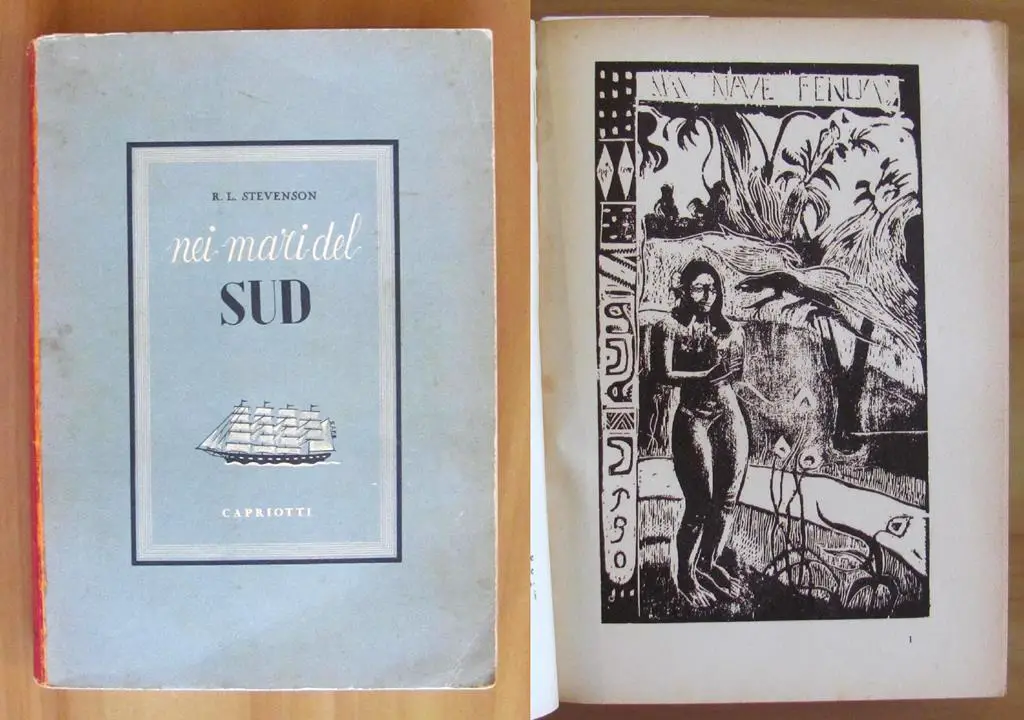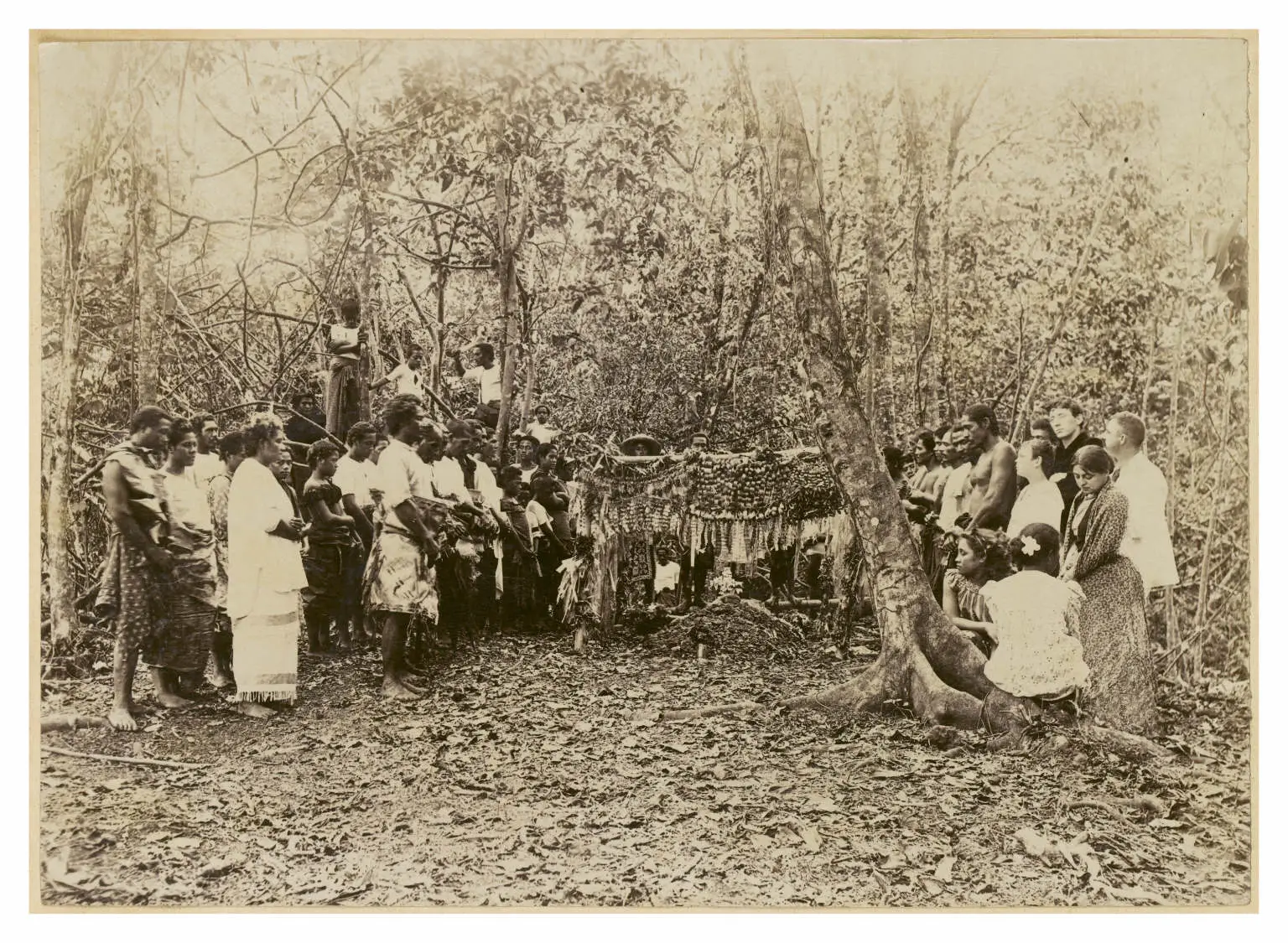In the exotic shops of Robert Louis Stevenson concerning the trips to the Pacific Ocean of the two-year period 1888-89, thanks to his anthropologist's eye, the "Thanatic obsession" of the native populations of the South Seas emerges, as well as the remnants of a folkloric tradition and mythic which, although already almost completely destroyed by colonists and missionaries, gives the impression of never being completely eradicated.
by Marco Maculotti
cover: Stevenson (seated center) with family and some friends in Upolu, Samoa

Once GK Chesterton he remarked, speaking of Robert L. Stevenson, as the extreme "versatility and artistic dexterity" was for him a kind of curse: "not because he succeeded abbastanza well in the most diverse genres, but because, in the most diverse genres, it succeeded too well. Able to accomplish the proverbial miracle of being in five places at the same time, he led others to believe that he was five different people. " Perhaps the only one Edgar Allan Poe, among the writers of the nineteenth century, he applied himself with such deserving results to the most disparate narrative projects, ranging from the yellow tale to the grotesque, from the horror literature to the seafaring one.
And Stevenson himself, known to most for writing The Strange Case of Dr. Jekyll and Mr. Hyde (1886), he successfully devoted himself to, among other things, the oceanic narratives, accomplishing, from this point of view, even more than Poe himself: if the latter had "limited" himself to dedicating some of his greatest literary masterpieces to the marine expanses (in addition to the novel Gordon Pym you have to remember the stories A descent into the Maelstrom e Manuscript found in a bottle), Stevenson went further, handing us his travel brochures In the South Seas [and. it., Tarka, Mulazzo (MS), 2015] of the two-year period 1888-'89, published posthumously in 1896, two years after his passing. It is a text that is indispensable today to better understand collective psychology e the most authentic and profound soul of those indigenous peoples of the Pacific area which appear, to the contemporary reader's gaze, increasingly distant not only chronologically and spatially but also ontologically from this advancing modern world; an unmissable concentration of observations from explorer and ethnologist, without neglecting the possibility of drawing gods parallels between a world that disappears (theirs) and another (ours) that already in Stevenson's watchful eyes, more than a century ago, seems inevitably destined, within a few decades, to follow him in the abyss of wild globalization.

"Una child like this and then death. All Tanakas die. And then more"- Here I go from Kanaques, a young woman from the Marquesas Islands confided to Stevenson in French, holding out her child in the direction of the interlocutor with both hands.
"And in a perspective of centuries", reveals the author, «I saw their fate similar to ours, death rising like the tide, and the day, already fixed, when neither Britons nor other races nor literary works nor readers would exist anymore».
If the obsessive thought of death and decadence was central in the European literature of the nineteenth century (think, in addition to the aforementioned Poe, of French decadence, Dorian Gray by Oscar Wilde, or even to the great Russian literature of Tolstoy and Dostoevsky), the remote archipelagos of the South Seas were certainly no exception, although they left us their own personal thanathic obsession through the testimonies of anthropologists and explorers, and not through epochal coming-of-age novels, disturbing horror stories or kaleidoscopic poems, as has happened instead in our European lands. "Coral grows, palm opens, man disappears»Says Marquesano.

"The thought of death is dominant in the mind of the Marquesans," writes Stevenson. “No race seems more vital to seeing it; and in the meantime death cuts it with both hands ». The dying races and cultures of the Pacific thus appear to Stevenson as the vanguard of the world to come, for the indigenous peoples of the more recent possessions of the British Empire as well as for ourselves, the native European people. Thus the author, wandering from island to island, from archipelago to archipelago, testifies to the last stirrings of the traditional culture of the South Seas, passing with ease from the description of the traditional socio-political systems, which gradually disintegrate over the years. more and more in favor of British influence, to the collation of "superstitious" legends and beliefs, which speak of demons, unresolved spirits and mysterious entities dwelling in unknown dimensions that, according to the indigenous people, in case of non-compliance with the taboos and ritual prescriptions, they would be able to enter our world, bringing chaos and disgrace.
But the question of the death and decay of native culture goes far beyond mere consideration of it as superstition or naive belief - an aspect that Stevenson, similarly to Rudyard Kipling with regard toIndia and Brazil, had the merit of understanding with the look of the anthropologist, lending itself to reporting the traditional tales concerning the most disparate deities and ghosts even where these have been told by extremely eccentric individuals, which almost bring to mind, for the way in which the author describes them, the jesters of the royal courts of Medieval Europe. How to frame, Stevenson wonders, the tragic question of the almost instantaneous disintegration, following the arrival of European settlers and missionaries, of local traditions?
«Where there have been fewer major or unimportant changes, wholesome or harmful, the breed survives», glosses. «Where there have been many […], the race perishes. Every change, even if it is of little importance, increases the sum of the new conditions to which the breed must get used to. […] The change of habits is more bloody than a bombing ».

Nonetheless, even when the traditional system seems close to imploding on itself, now on the verge of disappearing definitively in the face of the inevitable advance of so-called "progress", the more or less superstitious ancient beliefs do not completely disappear: and, among these, the one that most occupies the mind of the native peoples of the South Seas is, as mentioned, that of death, and therefore of ghosts and spirit entities that somehow manage to survive, bringing terror between their clan descendants. If indeed the mummies of children who died prematurely are kept inside the houses where they had spent their short life, "jealously preserved and carried from atoll to atoll in family wanderings", the corpses of adults who have recently passed away must be kept awake for nights and nights in order to prevent them from returning to food at night. of the souls of those who have survived them; this belief that finds its counterpart in the European tradition in the figure of the vampire. "A cannibal race can have cannibal ghosts»Writes Stevenson in his travel diary.
In fact, despite the superficial conversion of these ethnic groups to Christianity brought by the European missionaries, “on the whole expanse of the South Seas there is no one who can blame the neighbor. Mestizos and thoroughbreds, Christians and unbelievers, intelligent and stupid, all believe in spirits, all combine with their recent Christianity the fear of the old island gods". The spirits appear above all, similar to the fairies of the European tradition, in the wooded areas of the various islands, and especially where the megalithic remains of ancient sacrificial temples or clan tombstones, the marah and paepae, taboo places for the living, who prudently keep a safe distance from them, as such places "have become the outposts of the kingdom of the dead". In other times at these high-places sacred ceremonies took place and indigenous priests, on certain nights predetermined by the ritual calendar, had the right to sleep there; but today they are abandoned, and the tropical vegetation grows copiously on their rocky surface, which was once kept shiny with periodic applications of oil.

- spirits of the dead, which are sometimes confused, similarly to what happens in the tradition of the British Isles with the feral entities, often and willingly show themselves to the living, both in human and zoomorphic form, and even in other more bizarre forms: such as "a luminous form, a round, greenish head, a long, red body, with a brighter fire in the middle», Similar to a supernatural meteor or al Will-o'-the-Wisp of the English tradition. When they appear in their human features, the spirits avoid turning, always keeping their backs, so that the living cannot notice the principle of decomposition that furrows their faces and afflicts their limbs. Most of the time they manifest themselves with a hissing sound, a sort of "golden whistle"; particular, also this, which finds its faithful counterpart in the Scoro-Irish tradition and in the fantastic literature inspired by it, as for example in the tales of the Welsh Arthur Machen, who was among other things, as he himself admitted, a great admirer of Stevenson.
Other spirits of the island tradition, however, are significantly different from the souls of the dead, with which they cannot be confused: it is the case, for example, of A lot, oceanic deity of the native populations of Samoa who is configured "like a Proteus, endowed with unlimited transformations", and who believed himself capable of transporting indigenous priests "from island to island across the archipelago", with a sort of magical flight. Other aquatic deities, on the other hand, closely resemble the various Nymphs, Undines, Nereids and silkies e Nixies of the Western tradition: beautiful women who dwell "in the various brackish ponds and gore", "with long red hair", who appear from time to time intent on bathing; but, very timid, "at the slightest sound of footsteps on the coral they plunge again forever." Likewise ai fairies in the British tradition they "are known as a living people […] inhabiting an underground kingdom". Similar to the hidden people of European legends are also the Vahinehae, "Hungry spirits of the dead, who [...] are hidden everywhere, invisible [and] they go to dance, at night, around the paepae of their old family. "

Nonetheless, at the end of the nineteenth century the obsession of the native populations of the Pacific islands with death did not concern only folklore and mythical beliefs, but also gave birth, similar to what happened in the Americas, to real millennial cults, such as Ghost Dance North American and the South American eschatologies of the "Earth-Without-Evil". It is the case of the Tahitian brotherhood of Oro, a divinity that Stevenson associated from a comparative point of view "with the Bacchus of the ancients". His followers "sailed from bay to bay and island to island", being "welcomed everywhere with feasts", "they sang, danced, gave performances and shows of dexterity and strength, and they were poets and lenons of the archipelago. Their life was public and epicurean, their initiation a mystery».
And yet, despite this extremely vital attitude, if only in the eyes of the layman, their sect envisioned the killing of all children who were conceived within the brotherhood, with the sole exception of one of the children of the couple called by right of succession to assume command, to ensure the continuation of the cult:
"A free Freemasonry, a sect of agnostics", comments Stevenson, «A company of artists of which all the members were under the oath not to remain chaste and all with the prohibition of leaving a lineage […]. Hunger threatened the islands and the remedy that caused horror was proposed to the indigenous soul under those appearances of mystery, pleasure and parade.».


2 comments on “Robert Louis Stevenson "in the South Seas""